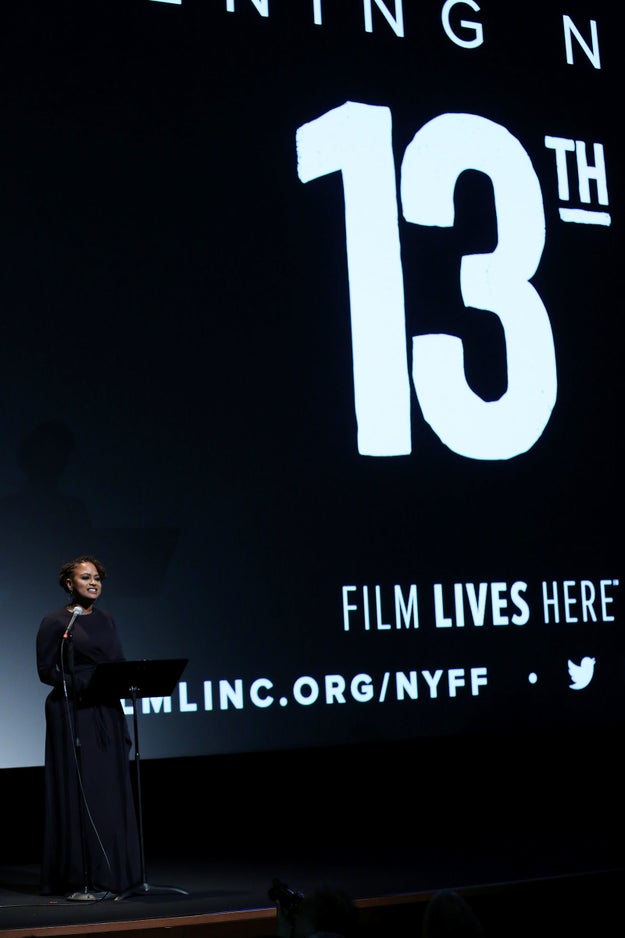
Ava DuVernay speaks at the New York Film Festival premiere of her Netflix documentary 13th. Marion Curtis / Via Netflix
Ava DuVernay’s documentary 13th is full of archival footage that is difficult to watch. But at a press conference for the film in early October, before its premiere at the 54th Annual New York Film Festival, DuVernay said there was one clip above all that she couldn’t “watch that without tearing up” — a moment she refers to as “Story of a Dignified Man.”
In the clip, a well-dressed black man in a hat walks down a street in Arkansas in the late 1950s. Behind him is an angry mob of white men, climbing over each other to harass and physically assault the man — they punch, they kick, they pounce, but the only reaction they are able to stoke from him is a pause to pick up his hat. He refuses to run, he refuses to engage, and is left beaten and bloodied by the time he reaches his car.
DuVernay’s 13th lets the video of Wilson’s assault speak for itself at first in the context of the Civil Rights Movement, but as the film begins to touch on the modern political climate, the “Story of a Dignified Man” is cross-cut with videos from Donald Trump rallies where black men and women are physically shoved out the door or punched in the face.
At the press conference, DuVernay said she went back and forth as to whether or not she would include Trump in a documentary about slavery and the prison industrial complex. “It was a question that we had to play with: Take him out, leave him in, does he deserve a place in this thing, such and such,” she said. “But you’ve got to show that stuff because it’s too important and it can’t be forgotten.”
DuVernay added: “I think it is vital to have him in there because he is taking this country to a place that is … going to have repercussions past this moment, regardless of whether he’s the president or not. … So we need to remember this moment just like we remember… the Bush-Dukakis race earlier, and it gives us context to this moment that we’re in, looking at it through the lens of race and culture.”
The man in the “Story of a Dignified Man” is L Alex Wilson, a well-respected black journalist and editor who was covering the protests outside of the first high school in Arkansas to integrate after the Brown v. Board of Education case in the Supreme Court made segregation unconstitutional. After 19 days, the Arkansas National Guard had withdrawn from their deployment to block the students from entering the school, and as a mob began to crowd the Little Rock Nine on their way into the building, Wilson, along with three other black journalists, weaved into the crowd with them.
Suddenly, Wilson was hit with a swift kick to the back, followed by another blow, and another one, until the angry mob’s focus shifted from the students and onto the tall, lanky black journalist who was there to report on the scene for the Tri-State Defender. The students were able to finally attend school, and Wilson’s peers were able to escape with little damage, but when they called for Wilson to run away with them, he refused. Bystanders recalled that between blows, Wilson yelled, “I fought for my country in the war and I’m not running from you.”
Pictures and video of the riot against Wilson made national news, so much so that the next day, President Eisenhower went against Arkansas Governor Faubus and the state’s National Guard by deploying members of the U.S. army to protect the nine black students on their way into school.
Wilson made his deadline and wrote in his article the next day: “I decided not to run. If I were beaten, I’d take it walking if I could – not running… Any newsman worth his salt is dedicated to the proposition that it is his responsibility to report the news factually under favorable and unfavorable conditions… I am not bitter… I believe that justice and fair-play for all minorities will eventually triumph in the tension-ridden social revolution which has gripped the South.” Wilson continued to work as a journalist for the next three years until he died from illnesses that are believed to be tied to his assault in Arkansas.


